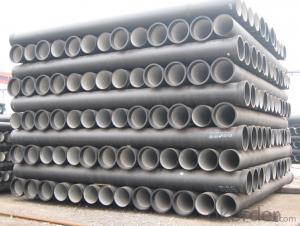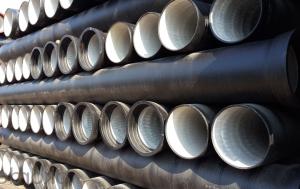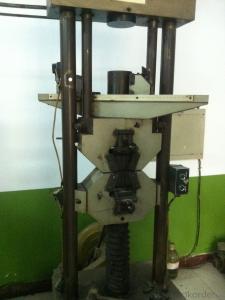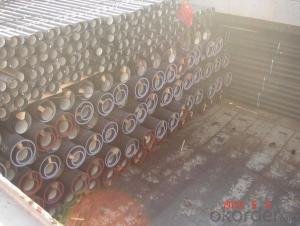DUCTILE IRON PIPES AND PIPE FITTINGS K8 CLASS DN150
- Loading Port:
- Tianjin
- Payment Terms:
- TT OR LC
- Min Order Qty:
- 22 pc
- Supply Capability:
- 3000 pc/month
OKorder Service Pledge
OKorder Financial Service
You Might Also Like
Material : Ductile Cast Iron
Size Range : DN 80mm to DN 2000mm
Unit Effective Length : 6m or 5.7m
Manufacture Standard: ISO 2531:1998/ EN 545:2006/EN 598:2007
Annual capacity : 200,000 tons
Coating Exterior: Zinc 130g/m2 according to ISO 8179-1 and bitumen coating 70 microns.
Cement Interior: Portland Cement/ High Alumina Cement/ Sulphate Resisting Cement Lining according to ISO 4179
Special requirements on external coating and internal lining can be applied
We also provide accessories such as SBR/EPDM rubber gaskets, lubricant paste, pipe caps, PE sleeves, etc.
Additional Parts:
Each pipe is strictly inspected according to related standard to ensure permanently high performance.
Easy Installation at site and service free for life
Long Service Lifespan
Quotation will arrive you within 24hours once we get your inquiry.
We guarantee offering you a competitive price.
A copy of original inspection reports of pipes will be offered after shipment.
Photos of loading process will be sent to the customer after shipment effect.
We will follow-up the delivery progress after shipment effect and update to the customer on weekly basis.
- Q: Can ductile iron pipe be used for hot water applications?
- Indeed, hot water applications can make use of ductile iron pipe. Renowned for its robustness, longevity, and exceptional resistance to corrosion, ductile iron pipe proves itself ideal for diverse applications, including hot water systems. Its capability to withstand high temperatures and pressure renders it a dependable choice for the conveyance of hot water. Moreover, its thermal conductivity properties facilitate efficient heat transfer, guaranteeing the effective delivery of hot water throughout the system. Consequently, when evaluating materials for hot water applications, ductile iron pipe emerges as a fitting alternative.
- Q: Are ductile iron pipes suitable for power plant cooling systems?
- Ductile iron pipes are well-suited for power plant cooling systems, offering numerous advantages that render them perfect for such applications. Firstly, their high strength and durability enable them to withstand the immense pressure and heavy loads typically associated with power plant cooling systems. Additionally, these pipes exhibit excellent resistance to corrosion, a vital feature in an environment where water and other cooling fluids continuously flow. Moreover, they boast good thermal conductivity, ensuring efficient heat transfer away from power plant equipment and contributing to the overall cooling process. Lastly, ductile iron pipes are cost-effective compared to other commonly used materials in power plant cooling systems, making them a practical choice. Ultimately, due to their strength, corrosion resistance, thermal conductivity, and cost-effectiveness, ductile iron pipes represent a reliable and suitable option for power plant cooling systems.
- Q: What are the specifications of cast iron pipes?
- The nominal diameter of the continuous grey cast iron pipe is 75~1200 mm. It adopts the form of socket type or flange disk interface. It can be divided into two kinds of flexible interface and rigid interface according to function. The length of the straight pipe is 4 meters, 5 meters and 6 meters. According to the wall thickness, LA, A and B are divided into three grades. The nominal diameter of the centrifugal cast iron pipe of the sand mould is 200~1000 mm, the effective length is 5 meters and 6 meters. According to the wall thickness, it is divided into two grades: P and G. High strength, good toughness, thin tube wall, little metal consumption, and can bear higher pressure,
- Q: How are ductile iron pipes protected against internal corrosion?
- Ductile iron pipes are protected against internal corrosion through a combination of various preventive measures. One of the primary methods is the application of a protective coating on the inner surface of the pipe. This coating acts as a barrier between the pipe and the transported fluid, preventing direct contact and minimizing the chances of corrosion. Another common method used is the application of a cement mortar lining. This lining further enhances the protective barrier, reducing the likelihood of corrosion even in aggressive environments. The cement mortar also provides a smooth surface, reducing friction and improving the flow of water or other fluids through the pipe. In addition to coatings and linings, ductile iron pipes are often designed with corrosion-resistant alloys or additives. These alloys, such as zinc or epoxy, are added during the manufacturing process and provide an extra layer of protection against internal corrosion. They act as sacrificial anodes, corroding over time to protect the underlying iron from degradation. Regular maintenance and inspection are also crucial in protecting ductile iron pipes against internal corrosion. Monitoring the condition of the protective coatings, identifying any signs of degradation or damage, and promptly addressing any issues are essential to ensure the long-term integrity of the pipes. Overall, a combination of protective coatings, cement mortar linings, corrosion-resistant alloys, and regular maintenance efforts work together to effectively protect ductile iron pipes against internal corrosion, extending their lifespan and ensuring the safe transportation of fluids.
- Q: What is the expected pressure rating of ductile iron pipes?
- The pressure rating of ductile iron pipes can vary depending on factors like pipe diameter, wall thickness, and installation joint type. However, ductile iron pipes are generally recognized for their durability and ability to handle high pressure. In most instances, ductile iron pipes are designed and produced to meet or surpass industry standards like AWWA C151 or C115/A21.15. These standards establish the minimum pressure rating for ductile iron pipes, which typically range from 150 to 350 psi for water transmission purposes. It's important to note that the pressure rating is also influenced by the pipe's class, which corresponds to the wall thickness. Ductile iron pipes are commonly available in different classes such as Class 50, Class 51, Class 52, etc. Each class has its own pressure rating, with higher classes offering greater strength and pressure resistance. To determine the exact pressure rating, it is advisable to refer to the manufacturer's specifications and guidelines for the specific ductile iron pipes being used. Additionally, other factors like pipe support, installation methods, and operating conditions should be considered to ensure the safe and efficient functioning of the ductile iron pipe system.
- Q: Can ductile iron pipes be used for potable water systems?
- Indeed, potable water systems can utilize ductile iron pipes. Ductile iron, which undergoes treatment with magnesium to enhance its strength and flexibility, characterizes this type of iron. These pipes are esteemed for their robustness, resistance to corrosion, and ability to endure high pressure. They are frequently employed in water distribution systems, inclusive of potable water supply. Nevertheless, guaranteeing that the ductile iron pipes employed in potable water systems adhere to the requisite standards and regulations set by local authorities, such as NSF/ANSI 61 for drinking water system components, is of utmost importance. Consistent maintenance and regular testing are also indispensable to ensure the ongoing safety and excellence of the potable water system.
- Q: Do ductile iron pipes require pressure testing before installation?
- Before installation, it is necessary to conduct pressure testing on ductile iron pipes. This step is critical in guaranteeing the pipes' integrity and safety. Its purpose is to detect any leaks, weaknesses, or defects before the pipes are put into service. Pressure testing involves subjecting the pipes to higher-than-normal operating pressures to determine if they can endure the expected pressure without any failures. By doing so, this process prevents potential issues such as leaks, bursts, or failures that could result in water loss, property damage, or accidents. Hence, pressure testing is an indispensable requirement for ductile iron pipes to ensure their reliability and long-term performance.
- Q: What are the advantages of using ductile iron pipe over HDPE pipe?
- There are several advantages of using ductile iron pipe over HDPE pipe. Firstly, ductile iron pipe is known for its high strength and durability. It is able to withstand higher pressure and is less likely to leak or burst compared to HDPE pipe. This makes ductile iron pipe a reliable choice for applications where high-pressure water or gas transmission is required, such as in municipal water supply systems or industrial piping networks. Secondly, ductile iron pipe has a longer lifespan compared to HDPE pipe. It is highly resistant to corrosion and can last for several decades, even under harsh environmental conditions. This reduces the need for frequent replacements, resulting in cost savings over time. Moreover, ductile iron pipe has excellent fire resistance properties. It can withstand high temperatures without compromising its structural integrity. This makes it a reliable choice for applications where fire safety is a concern, such as in fire hydrant systems or sprinkler systems. Additionally, ductile iron pipe is known for its superior flow characteristics. Its smooth inner surface reduces friction loss, allowing for efficient and consistent flow of fluids. This is particularly important in applications where maximum flow capacity is required, such as in water distribution systems or wastewater treatment plants. Furthermore, ductile iron pipe is highly recyclable. It can be melted down and reused to manufacture new pipes, reducing the environmental impact and promoting sustainability. In conclusion, the advantages of using ductile iron pipe over HDPE pipe include its high strength and durability, longer lifespan, fire resistance, superior flow characteristics, and recyclability. These factors make ductile iron pipe a preferred choice for various applications, especially those that require high-pressure transmission, longevity, fire safety, efficient flow, and environmental sustainability.
- Q: Can ductile iron pipe be recycled?
- Yes, ductile iron pipe can be recycled. Ductile iron is a type of iron that is commonly used in the manufacturing of pipes due to its high strength and durability. When a ductile iron pipe reaches the end of its useful life, it can be recycled by melting it down and using the molten iron to create new products. Recycling ductile iron pipe not only helps conserve natural resources but also reduces the need for raw materials and energy-intensive processes involved in manufacturing new pipes. Additionally, recycling ductile iron pipe helps minimize waste and contributes to a more sustainable and environmentally friendly approach to infrastructure development.
- Q: Ductile iron pipe length is generally much
- The spheroidal graphite tube of hot film casting process is generally a single branch with a length of 8 meters. The ductile iron pipes produced by this process are usually large caliber pipes. For example, DN1000 or more.
Send your message to us
DUCTILE IRON PIPES AND PIPE FITTINGS K8 CLASS DN150
- Loading Port:
- Tianjin
- Payment Terms:
- TT OR LC
- Min Order Qty:
- 22 pc
- Supply Capability:
- 3000 pc/month
OKorder Service Pledge
OKorder Financial Service
Similar products
Hot products
Hot Searches
Related keywords























